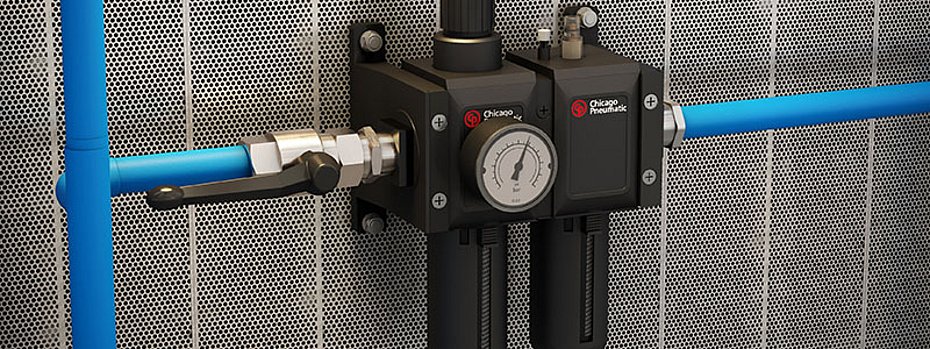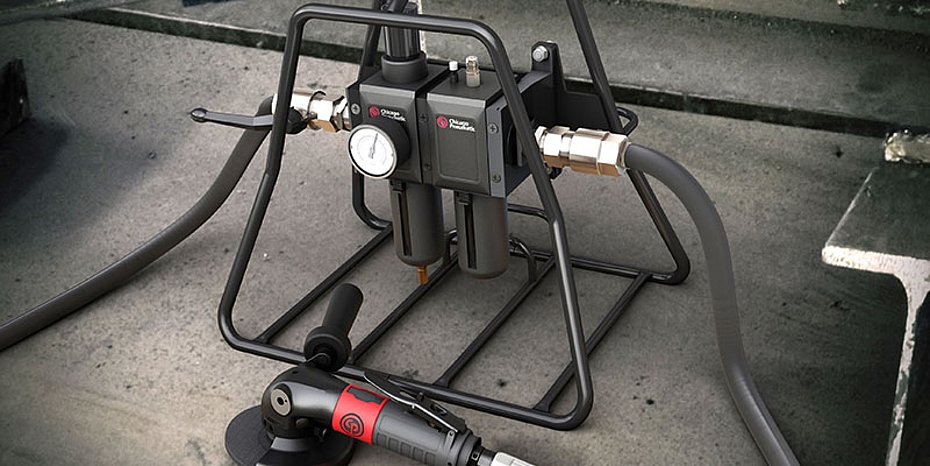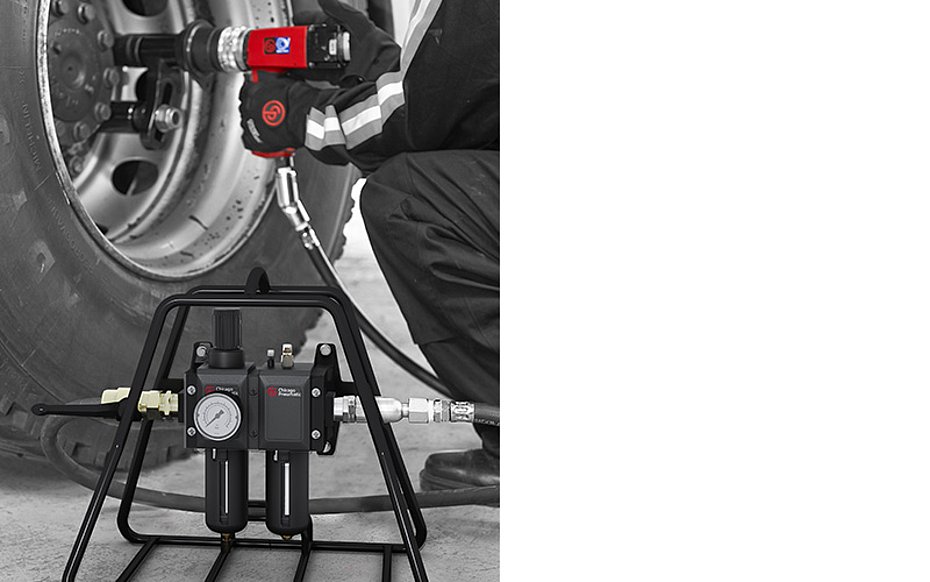New maintenance units reduce pressure losses in the piping system by 50 percent
Powerful tools need efficient compressed air preparation: Losses in compressed air line systems can be reduced by up to 50 percent with the new compressed air maintenance units from the manufacturer Chicago Pneumatic, and the service life of pneumatic tools can also be extended.
The manufacturer Chicago Pneumatic introduces new compressed air maintenance units that work particularly efficiently and extend the service life of pneumatic tools. With the FRL units, pressure losses between the compressor and the tool are reduced by half compared to conventional maintenance units. Energy costs and CO2 emissions can thus be reduced by around 10 percent. Valuable installation tips for compressed air maintenance units round off this article.
Chicago Pneumatic is launching new maintenance units for energy-saving compressed air preparation. The units consist of a compressed air filter, pressure regulator and lubricator. They improve the performance and extend the service life of pneumatic tools connected to the respective compressed air line in harsh industrial environments. This is because the FRL units ensure that clean and properly lubricated air arrives at the tool at the correct pressure.
Three service units are available for different line diameters: the FRL12BSP, FRL34BSP and FRL1BSP. The abbreviation "FRL" stands for the English terms "Filter, Regulator, Lubricator". The "BSP" stands for the type of pipe thread connection commonly used in Europe ("British Standard Pipe"), and the number in the middle indicates the respective connection diameter in inches (1/2", ¾", 1").
Diaphragm valves limit the pressure drop even with high air consumption
The special diaphragm valves of the new FRLs limit the pressure drop even at high air flow rates, Chicago Pneumatic says: "While losses can never be completely avoided with such equipment, the FRL maintenance units show a lower and more stable pressure drop than previous models and than other maintenance units on the market, with the same tool and identical air consumption.
Compressor can be set to lower pressure
At other maintenance units, a pressure drop of ΔP = 1.6 bar was measured with the same compressed air consumption of the grinding machine of 35 l/s. In this case, the compressor must be set to about 8 bar (not counting further pressure losses due to branches, switches or constrictions in the line system). This means high energy losses, knowing that a 1 bar higher working pressure increases the air consumption by up to 16 %. On the other hand, a pressure loss of 1 bar is equivalent to a 25% loss of machine performance.
In concrete comparison with the traditional maintenance units, the pressure loss of the new Chicago Pneumatic units is reduced by 50% (from 1.6 bar to 0.8 bar). According to the manufacturer's findings, this could reduce energy costs andCO2 emissions by around 10% on an extrapolated basis. Those who pay attention to efficiency should therefore run the compressor at the lowest possible pressure: This is the pressure that provides consumers with enough air for optimum performance, while not wasting energy.
New maintenance units only two-stage
CP's new maintenance units basically consist of only two stages, with the filter and regulator designed as a single unit. Previous maintenance units were designed with two or three stages. Three-stage means that although the filter, regulator and lubricator are combined into one device, they operate separately one after the other.
Filters keep the compressed air free of moisture and dust particles, and also remove any condensate from the compressed air. This protects the mechanics, reduces wear on the tools and prevents possible damage from corrosion. The filters of the three new service units retain particles with a diameter of 5 µm or more. The condensate drains operate semi-automatically on the FRL12BSP and automatically on the other two units. Pressure regulators keep the working pressure at the level set for the mold. The flow pressure at the mold should normally be 6.3 bar.
An oiler, in turn, is used for controlled lubrication of the moving motor parts of the tool, for example, the flaps in a pneumatic flap sander. The most common are mist lubricators, which release the oil into the air drop by drop in the defined quantity. In FRL maintenance units, the oil is automatically replenished from a small tank, which simplifies maintenance. (OM-02/23)
Maintenance units are designed to get the optimum performance out of the connected molds. To do this, they must always be mounted as close as possible to the mold, preferably where the mold hose is coupled to the pipe installation. Ideally, they are placed directly downstream of the pipe tapping point first, so that the compressed air arrives at the mold in the right quality. This installation allows the maintenance units to work most efficiently, reducing tool downtime and thus increasing productivity. If the workstation is located quite far from the permanently installed piping, small, portable stands that support the maintenance units can be used. The stands have two connections for compressed air hoses, which are connected to the pipeline on one side and lead to the tool on the other.
Contact
Chicago Pneumatic Brand Sales
Desoutter GmbH
Edmund-Seng-Strasse 3-5
63477 Maintal (Germany)
Phone +49 (0)6181-411-130
E-mail info.cp@cp.com
www.cp.com



